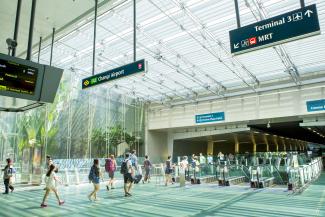
Singapore, 29 September 2021 (Wednesday) – The Institute of Service Excellence (ISE) (卓越服务研究院) at Singapore Management University (SMU) today released the 2021 second quarter (Q2) Customer Satisfaction Index of Singapore (CSISG) research findings for the Land Transport sector.
The annual study looked at local commuters’ travel behaviours and their experiences in three distinct sub-sectors: The Mass Rapid Transit (MRT) System, Public Buses, and Point-to-Point Transport.
The latest findings show that a majority of commuters interviewed, 61.1%, indicated their commuting patterns have changed since the start of the Covid-19 pandemic, with a significant proportion of them indicating fewer trips on the MRT (24.7%) and Public Buses (18.3%). In contrast, 15.7% indicated they were relying more on Point-to-Point Transport for their commutes; this included both taxis and private hire cars from ride-hailing services such as Grab and Gojek.
However, in terms of customer satisfaction, the Point-to-Point Transport sub-sector saw a statistically significant year-on-year decline, falling 3.6% to 73.1 points, on a 0 to 100 scale. On the other hand, the MRT System sub-sector scored 74.2 points while the Public Buses sub-sector scored 74.4 points; both scores were statistically similar to the previous year.
“While we are observing commuters gravitate towards taxis and private hire cars for their commuting needs, likely for the perceived increase in safety from an endemic Covid-19, the decline in satisfaction year-on-year does suggest pain points have been developing,” said Ms Neeta Lachmandas (妮塔.拉切曼达斯), Executive Director (执行总监) of ISE.
The lower customer satisfaction scores come on the back of poorer performances in several quality attributes tracked in the study. The three lowest performing attributes, ‘Ease of getting a ride’, ‘Fare charged’, and ‘Attractiveness of app promotions & discounts’ all registered marked year-on-year declines.
“The poor performance of these pricing and ride acquisition-related attributes were supported by survey respondents’ verbatim comments alluding to high prices and poor availability,” added Ms Lachmandas.
“It’s understandable that Covid-19 has been disruptive to Point-to-Point Transport services, particularly in relation to driver supply and ride demand, but operators should review customers’ travel experience and work to strengthen themselves as the transport option of choice,” she surmised.
Within the MRT system and Public Buses sub-sectors, while satisfaction levels held steady year-on-year, some key metrics did register notable movements. Price tolerance, essentially commuters’ appetite to tolerate fare increases, fell from 9.9% in 2020 to 8.2% in 2021.
Mr Chen Yongchang (陈勇畅), Head of Research and Consulting at ISE, said, “The issue of price sensitivity has been observed not just in public transport but in other industries that we have measured. This recurring theme is likely driven by concerns over the economic environment.”
Impact analysis, which seeks to determine the most important levers to drive perceptions of quality, also revealed shifting priorities among public transport commuters.
Last year, ‘Accuracy of in-train information’, ‘Reliability’, and ‘Frequency’ were the most important drivers of quality for MRT commuters. This year, ‘Cleanliness of trains’, ‘Travel time’, and ‘Safety’ came out on top.
For Public Bus commuters, ‘Frequency’, ‘Ride comfort’, and ‘Ride smoothness’ came out on top last year, while ‘Safety’, ‘Accuracy of bus-arrival information’, and ‘Bus condition’ were the most important drivers this year.
“The importance of safety, likely spurred on by ongoing Covid-19 infections, has become an even more critical driver of quality for our public transport system this year,” commented Mr Chen.
“Public Transport Operators and relevant agencies should be cognisant to these sentiments and continue investing in these priority areas. A good example of addressing such key drivers is the recent roll-out of the new and improved Passenger Information Display Systems for bus stops, supporting bus commuters’ desire for more accurate bus-arrival information,” he remarked.
The CSISG 2021 Q2 study was conducted between April and June 2021. A total of 2,350 local residents were surveyed through online interviews.
Please refer to Annex A for a background on the CSISG and Annex B for the detailed scores.
***